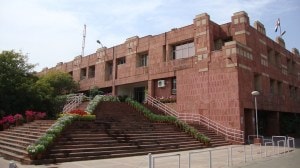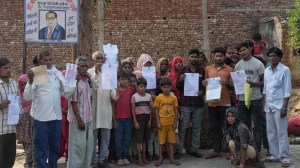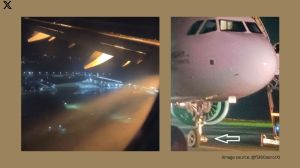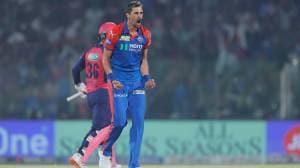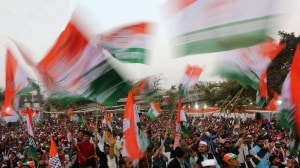UPSC Key: Supreme Court decision on Tamil Nadu Governor, Thucydides Trap and MSME Sector
Why the new criteria for the classification of Micro, Small and Medium Enterprises is relevant to the UPSC exam? What is the significance of topics such as math behind Trump's 104% tariff on Chinese goods, delimitation and India-Dubai relations, on both the preliminary and main exams? You can learn more by reading the Indian Express UPSC Key for April 9, 2025.
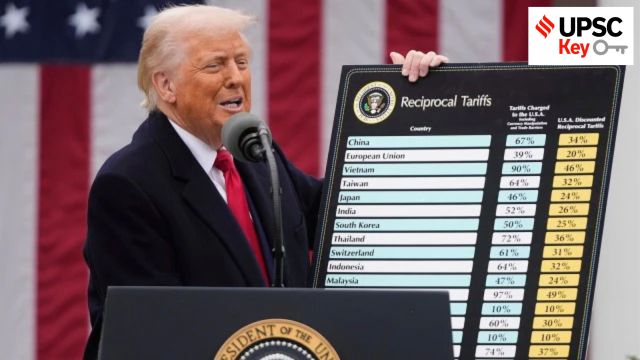 UPSC Key April 2025: Here's what you should be reading from the April 9, 2025 edition of The Indian Express
UPSC Key April 2025: Here's what you should be reading from the April 9, 2025 edition of The Indian Express Important topics and their relevance in UPSC CSE exam for April 9, 2025. If you missed the April 8, 2025 UPSC CSE exam key from the Indian Express, read it here
FRONT PAGE
‘Illegal’: SC sets aside TN Governor’s act of withholding assent to Bills
Syllabus:
Preliminary Examination: Indian Polity and Governance-Constitution, Political System, Panchayati Raj, Public Policy, Rights Issues, etc.
Mains Examination:
• General Studies II: Appointment to various Constitutional posts, powers, functions and responsibilities of various Constitutional Bodies.
• General Studies II: Functions and responsibilities of the Union and the States, issues and challenges pertaining to the federal structure, devolution of powers and finances up to local levels and challenges therein
What’s the ongoing story: In a decision with significant ramifications, the Supreme Court Tuesday declared as illegal and erroneous the action of Tamil Nadu Governor R N Ravi in reserving 10 Bills for consideration of the President in November 2024 after they had already been reconsidered by the state Assembly.
Key Points to Ponder:
• What exactly Supreme Court said about the Tamil Nadu Governor R N Ravi?
• What Tamil Nadu Governor did with the bills?
• Why the Supreme Court set aside Tamil Nadu Governor R N Ravi’s decision to withhold assent to 10 pending Bills?
• What are the important constitutional provisions related to the Governor?
• What does the Constitution say about the Governor’s role in giving assent to Bills passed by the state legislature?
• What had the Supreme Court said on this issue earlier?
• How Bills are passed in state assembly?
• What is role of governor in legislative procedure in state legislature?
• Every bill, after it is passed by the assembly or by both the Houses in case of a bicameral legislature, is presented to the governor for his assent. There are four alternatives before the governor-what are they?
• If the governor gives his assent to the bill, then what happens with the bill?
• If the governor withholds his assent to the bill, then what happens?
• Can the Governor withholds the Bills indefinitely?
• The governor enjoys only a suspensive veto-What is suspensive veto?
• How powerful is a Governor?
• Office of Governor-know the historical background
• Why has the Governor’s role and powers recently become a matter of contention?
• What is the relationship between the Governor and the state government?
• Various attempts were made to understand the role of the governor to strengthening centre-state relations-Can you name those committees and their recommendations?
• Administrative Reforms Commission of 1968, the Rajamanar Committee of 1969, the Sarkaria commission of 1988 and Punchhi Commission-What were their recommendations in the context of role of Governor?
• The Sarkaria Commission, set up in 1983 to look into Centre-state relations, proposed certain points for the selection of Governors-Know them in detail
• What Punchhi Committee, constituted in 2007 on Centre-state relations said on selection the Governor?
• The Punchhi Committee recommended deleting the “Doctrine of Pleasure” from the Constitution-What is “Doctrine of Pleasure”?
• “The standoff between the Tamil Nadu government and R N Ravi highlights a significant constitutional dilemma about the role and powers of the Governor”-Elaborate
• Discuss the constitutional role of the Governor in India’s federal structure.
• How do conflicts between Governors and Chief Ministers impact governance at the state level?
• Highlight the constitutional provisions governing the relationship between the Governor and the Chief Minister.
• “The Governor’s office should act as a neutral and constitutional authority.” Critically evaluate this statement in light of recent
controversies.
• Analyse the ethical responsibilities of constitutional authorities like the Governor in maintaining decorum and fostering cooperative federalism.
Key Takeaways:
• The bench of Justices J B Pardiwala and R Mahadevan ruled that any subsequent steps taken by the President, too, do not survive.
• It also laid down a timeline for Governors to decide on Bills presented to them.
• Exercising powers under Article 142 of the Constitution, the bench also declared the 10 Bills as having received assent given “the unduly long period of time for which these Bills were kept pending by the Governor before the ultimate declaration of withholding of assent and in view of the scant respect shown by the Governor” to the court’s decision in similar matters earlier.
• Soon after the judgement was pronounced, Attorney General R Venkataramani said, “On Article 142, there is going to be some issue on that. Permit me to come back to that.” But Justice Pardiwala said “the judgement has been pronounced”.
• Explaining its decision, the bench said that under Article 200 of the Constitution, which deals with the power of Governors to deal with Bills presented to them, there are only three courses open: grant assent; withhold assent; or, reserve the Bills for the President.
• It said the Bill can be reserved for the President only at the first instance. It said there is no concept of “absolute veto” or “pocket veto” under the Constitutional scheme.
• Delineating the role of the Governor, the bench said, “In times of conflict, he must be the harbinger of consensus and resolve issues, lubricating the functioning of the state machinery by his sagacity and wisdom, and not run it into a standstill. He must be the catalyst and not an inhibitor. All his actions must be held keeping in mind the dignity of the high Constitutional office that he occupies.”
• Laying down the timeline for Governors to decide on Bills, the judges referred to Article 200 which deals with the power of the head of the state to deal with Bills presented by the Assembly.
• The Supreme Court said that the general rule is that the Governor, in exercise of his functions under Article 200, has to abide by the aid and advice tendered by the Council of Ministers. The only exceptions to this rule can be traced to the second proviso to Article 200 and Article 163 (1), respectively.
Do You Know:
• Article 163 of the Constitution deals with the powers of the Governor generally. Article 200 specifically deals with the issue of granting assent to Bills. Both provisions are read together to determine the contours of the Governor’s power on this issue.
• When a Bill passed by the legislature of a state is presented to the Governor, the Governor has four options: (1) grant assent to the Bill; (2) withhold assent to the Bill; (3) return the Bill for reconsideration; or (4) reserve the Bill for the consideration of the President.
• Article 200 reads: “When a Bill has been passed by the Legislative Assembly of a State or, in the case of a State having a Legislative Council, has been passed by both Houses… it shall be presented to the Governor and the Governor shall declare either that he assents to the Bill or that he withholds assent therefrom or that he reserves the Bill for the consideration of the President.”
• An indefinite timeline in deciding on Bills can in effect, amount to paralysing the elected government. This was essentially the Tamil Nadu government’s argument — that the Governor virtually exercises a “pocket veto” by delaying his decision on granting assent.
• The Governor argued that he was exercising his discretionary powers in giving assent to Bills. However, this discretion cannot be used arbitrarily or based on a personal preference, but only in constitutional terms with cogent reasons.
• Additionally, Article 200 uses the word “shall” which indicates that the framers of the Constitution intended a mandatory tone for the Governor on this aspect.
• In its landmark 2016 ruling in the Arunachal Pradesh Assembly case (Nabam Rebia and Bamang Felix vs Deputy Speaker), the Supreme Court had discussed this aspect briefly.
• The recent decision by the Supreme Court relied on the 2023 ruling but went a step further, it prescribed a time limit for the Governor to exercise his powers under Article 200.
Other Important Articles Covering the same topic:
📍Among 10 Bills over which TN Governor faces SC ire: Those on varsities, 2 of ex-govt
UPSC Previous Year Prelims Question Covering similar theme:
1. Which one of the following suggested that the Governor should be an eminent person from outside the State and should be a detached figure without intense political links or should not have taken part in politics in the recent past? (2019)
(a) First Administrative Reforms Commission (1966)
(b) Rajamannar Committee (1969)
(c) Sarkaria Commission (1983)
(d) National Commission to Review the Working of the Constitution (2000)
2. Which of the following are the discretionary powers given to the Governor of a State? (2014)
1. Sending a report to the President of India for imposing the President’s rule
2. Appointing the Ministers
3. Reserving certain bills passed by the State Legislature for consideration of the President of India
4. Making the rules to conduct the business of the State Government
Select the correct answer using the code given below
a) 1 and 2 only
b) 1 and 3 only
c) 2, 3 and 4 only
d) 1, 2, 3 and 4
US slaps 104% tariff on China, says ready to talk to others
Syllabus:
Preliminary Examination: Current events of national and international importance.
Mains Examination: General Studies II: Bilateral, regional and global groupings and agreements involving India and/or affecting India’s interests.
What’s the ongoing story: The White House Tuesday announced that a sweeping 104 per cent tariff imports from China has gone into effect, deepening the economic standoff between Washington and Beijing.
Key Points to Ponder:
• Why 104% tariff imposed by the United States on Chinese goods?
• What’s the math behind Trump’s 104% tariff on Chinese goods?
• How 104% tariff imposition will affect global supply chains and the multilateral trading system?
• “While tariffs can protect domestic industries in the short term, they may hurt global economic recovery”—Discuss
• What is Thucydides’ Trap?
• “Thucydides’ trap”, USA and China diplomatic relations—Connect the dots
• Does Trump have the United States and China in a Thucydides trap?
Key Takeaways:
• According to a Fox Business report, the tariff—which takes into account existing levies and fresh duties under Section 301 of the Trade Act—will be enforced starting at 00:01 ET (04:01 GMT) on Tuesday, April 9.
• The move follows through on a threat issued by former President Donald Trump, who gave Beijing until Monday to withdraw its own retaliatory 34 per cent tariffs on American goods. With the deadline now expired and China standing firm, the White House is proceeding with additional measures.
• In a fiery post on Truth Social on Sunday, Trump declared, “If China does not withdraw its 34% increase above their already long-term trading abuses by tomorrow… the United States will impose ADDITIONAL Tariffs on China of 50%, effective April 9th.”
• The 104 per cent duty on Chinese products is expected to have significant ripple effects, not just for US-China relations but across global supply chains.
• Beijing has not yet formally responded to the announcement, but it has previously vowed to “fight to the end” if Washington continues to escalate the trade war.
Do You Know:
• China has issued a scathing white paper in response to President Donald Trump’s newly enforced 104 per cent tariff on Chinese goods, warning of retaliation and accusing the US of “economic bullying” and “unilateralism.”
• Titled “China’s Position on Several Issues in China-US Economic and Trade Relations,” the document denounces Washington’s trade strategy and lays out Beijing’s growing frustration, Chinese state media Xinhua reported. “There are no winners in a trade war,” it states. “China does not want to fight a trade war, but the Chinese government will never sit idly by and watch the legitimate rights and interests of the Chinese people be harmed and deprived.”
• The white paper asserts that the US is violating international trade norms and weaponising tariffs “to exert maximum pressure and seek private gain.” It frames the latest duties as part of a larger attempt to dominate global trade, criticising the “America First” agenda as a “zero-sum” pursuit that threatens global stability.
• The document also details the evolution of bilateral trade, highlighting how the volume has grown from less than $2.5 billion in 1979 to nearly $688.3 billion in 2024, with two-way investment exceeding $260 billion.
• China, which was America’s second-largest source of imports last year, shipped $439 billion worth of goods to the US, compared to $144 billion in American exports to China. The rising tariffs now threaten to hit domestic industries hard, with businesses warning of cost surges, layoffs, and reduced competitiveness.
• By the end of Trump’s first term, the average US tariff on Chinese goods stood at 19.3 per cent, according to the Peterson Institute for International Economics. The Biden administration largely maintained those tariffs — even expanding them — bringing the average to 20.8 per cent.
Other Important Articles Covering the same topic:
📍In the US-China tariff war, who is likely to blink first?
THE EDITORIAL PAGE
Syllabus:
Preliminary Examination: Current events of national and international importance.
Mains Examination: General Studies II: Effect of policies and politics of developed and developing countries on India’s interests.
What’s the ongoing story: Ashutosh Varshney writes: The implementation of Trump’s electoral mandate will seriously undermine globalisation, now more than four decades old
Key Points to Ponder:
• How do political cycles in democracies influence trade policy decisions?
• Do tariffs in democratic countries reflect economic rationale or political compulsion?
• Examine the tension between electoral populism and long-term economic planning.
• “While democratic governments may impose protectionist tariffs to meet electoral demands, such policies are inherently unsustainable in the long run.”—Comment
Key Takeaways:
Ashutosh Varshney writes:
• President Donald Trump’s tariff blitzkrieg raises a difficult, though important question. Are democracy and globalisation increasingly at odds?
• The reason for posing the question this way is quite simple. Tariffs were an integral part of Trump’s campaign for an election that he won. One may argue that his campaign did not include a frontal attack on universities or law firms.
• It was at best a subsidiary theme. But the centrality of tariffs to the campaign was beyond doubt. Raising tariffs can thus be viewed as an expression of a democratic mandate. The implementation of this mandate, however, will seriously undermine globalisation, now more than four decades old.
• Between the mid to late 1970s and 2008, trade as a share of global GDP rose from 37 per cent to 61 per cent (2008 was the highest point of globalisation; since then, trade’s share of the world’s GDP has declined somewhat).
• Producing as much as 25 per cent of global GDP, America is still the world’s biggest economy and largest market. When tariffs raise the price of selling goods in such a large market, with retaliatory tariffs emerging in other big economies, free movement of goods across national borders is bound to suffer.
• Since trade has been so central to the international economy, worldwide income deceleration should be expected. US democracy and globalisation have entered a period of conflict.
• Note that this empirical point is different from whether US tariffs are economically desirable or justified. The size of the tariffs can certainly be critiqued.
• The formula for the calculation of tariff rates for each trading country can also be lambasted. The formula for each country is as follows: ½ (size of trade deficit divided by the size of imports).
• Those economists whose work has been cited by the Trump administration to calculate the size of the tariffs say they have been misused or misunderstood. But a welfare or economic critique of tariffs is wholly different from its political logic. The two logics, political and economic, are not aligned.
Do You Know:
Ashutosh Varshney writes:
• In theory, globalisation represents the free movement of capital, goods and labour across national boundaries. In reality, compared to capital and goods, labour was always allowed lower freedom to move, though all moved more than before. Thus, the actually existing globalisation came to mean two things: One, greater overall economic freedom beyond national borders; or loosening of national control over economic activity. And two, within that larger trend, freer movement of capital and goods than of labour.
• Trump’s attack on globalisation has two aspects. Immigration controls would restrict the movement of labour, and tariffs would create new obstacles for the movement of goods. Only capital would in principle be free to move but that too can be viewed as falling under new controls. He wants capital from everywhere to come to the US, but would make it harder for American capital to move abroad.
• Politically speaking, why is all this happening? Trade theory was rooted in the doctrine of comparative advantage – Americans producing airplanes, Japanese producing cars, Chinese producing textiles and footwear, Indians producing software.
• If each produced what it was good at and exported it, while importing what others were good at, free trade would benefit all. Theoretically, all boats would be lifted.
• There is no doubt that over the last 40-odd years of globalisation, more people have come out of poverty than ever before. Over a billion have been pulled out of poverty by the growth processes unleashed by globalisation, especially in China, India and Indonesia, three of the largest countries. Inequality between nations has gone down. Asia’s rise in particular is noteworthy. In 1980, China and India had the 50th and 51st largest GDPs in the world. They are the second- and fifth-largest today.
• The economic inequalities have had serious political consequences. Populist politics, which Trump embraces, and rising inequalities are integrally connected. As an ideology, populism claims to authentically represent the people, the masses, the average Joe and Jane, against a globally networked elite and the global arrival of immigrants.
• The American version of populism also has an added dimension. It comes with an attack on the so-called “deep state”, the part of the state that is not dependent on periodic elections and has a longer term. It does not wield power right at the top of the polity, but does so via the civil services lodged in the echelons below the political summit. The populist argument is that the deep state serves the elite, not the masses.
• In its current incarnation, democracy has undoubtedly provided the rationale for tariffs. Democracy is also likely to produce a reaction against it, as the full consequences become clearer. Whether that will lead to a restoration of globalisation remains unclear.
Other Important Articles Covering the same topic:
📍Trump’ tariffs and market fall — India needs to be better prepared
THE IDEAS PAGE
For united India, freeze Lok Sabha
Syllabus:
Preliminary Examination: Indian Polity and Governance-Constitution, Political System, Panchayati Raj, Public Policy, Rights Issues, etc.
Mains Examination:
• General Studies I: population and associated issues
• General Studies II: Government policies and interventions for development in various sectors and issues arising out of their design and implementation.
What’s the ongoing story: Arvind P. Datar Writes: In a nation plagued by many controversies, many of them avoidable, a serious problem that threatens to create a rift between the Northern and Southern states is the delimitation issue.
Key Points to Ponder:
• What is delimitation?
• Why are southern states nervous about delimitation?
• What can be the constitutional, political, and demographic implications of lifting the freeze on Lok Sabha seat delimitation?
• How demographic shifts and variations in fertility rates among states influence political representation in India.
• Discuss the impact of population-based representation on economic development and governance.
• Should economic contribution and governance parameters be considered in delimitation?
• Do you think that population-based redistribution of Parliamentary seats could undermine the federal balance and unity of India?
Key Takeaways:
Arvind P. Datar Writes:
• Article 81(1) mandates that the Lok Sabha shall consist of not more than 530 members who have to be chosen by direct election from territorial constituencies in the states; another 20 members are to represent the Union Territories.
• Currently, the Lok Sabha has a strength of 543 seats. Article 81(2) requires the allotment of seats to each state to be in proportion to its population, with the further condition that the ratio between the population of a state and the number of seats allocated shall, as far as practicable, be the same for all the states.
• Article 82 requires the readjustment of seats after the completion of each Census, and it will now have to be done under the Delimitation Act, 2002.
• From 1951 to 1971, the readjustment of seats took place after each decennial Census, with states gaining or losing a few seats depending on their population.
• The 42nd Amendment, passed during the Emergency, when most opposition members were in jail, froze the number of seats allocated based on the 1971 Census and declared that there would be no reallocation till the results of the 2001 Census were published.
• In 2002, when Atal Bihari Vajpayee was the prime minister, the readjustment was postponed by another 25 years by the 84th Amendment to the Constitution. This time, the reason for not allocating seats according to each state’s population was striking: “Keeping in view the progress of family planning programmes in different parts of the country, the Government, as part of the National Population Policy strategy, recently decided to extend the current freeze on undertaking fresh delimitation up to the year 2026 as a motivational measure to enable State Governments to pursue the agenda for population stabilisation.”
• Thus, all elections to Parliament and the legislative assemblies have been based on the 1971 Census for the last five decades. Although no Census has been held since 2011, any readjustment of seats based on population proportionality will result in a reduction of seats for southern states. The reasons that justified the 84th amendment prevail in 2025 as well because the freeze on delimitation has not resulted in population stabilisation.
• An article by Alistair McMillan in Redistricting in Comparative Perspective, a publication of the Oxford University Press, points out that while the estimated population increase from 2001 to 2026 for the entire country is 38.2 per cent, the increase in the population of Uttar Pradesh and Uttarakhand has been 55.33 per cent, and 51.4 per cent for Bihar and Jharkhand. In contrast, the increase in Tamil Nadu, Maharashtra and Karnataka has been 15.5 per cent, 28 per cent and 24.2 per cent respectively.
• Although Article 81 mandates the same proportionality for all states, this is only “so far as practicable”. These words in Article 81(2) have enabled significant departures from proportionality. For example, Goa has two members in the Lok Sabha for a population of 1.5 million, but New Delhi, with a population of 33.80 million, has seven.
Do You Know:
Arvind P. Datar Writes:
• An examination of the functioning of Parliament and state assemblies over the last 30 years establishes that an increase in their numerical strength will make no difference. If the number of MPs had been increased to 700 in the last decade, it would have resulted neither in better laws being passed nor in the improved functioning of the Lok Sabha.
• There are several disadvantages to having more legislators. In the first place, there is a huge cost to the exchequer by way of increased housing and other infrastructural expenses with zero benefits. Further, under Article 75(1A), the strength of the Council of Ministers can be up to 15 per cent of the total number of members for the Lok Sabha. Therefore, one could have a cabinet of 90 to 100 ministers at the Centre. There would be a similar increase in the size of cabinets in the states with little or no improvement in administration or in resolving India’s economic and social challenges.
• It is, therefore, necessary to complete the Census but discontinue the process of delimitation based on the principle of population proportionality. It is advisable that Articles 81, 82 and other constitutional provisions are amended to freeze the current strength of Parliament and every assembly, irrespective of the results of any decennial census. This is particularly necessary because the principle of population proportionality has become unworkable due to asymmetric demographic changes.
Other Important Articles Covering the same topic:
📍Don’t make delimitation North vs South
UPSC Previous Year Prelims Question Covering similar theme:
3. How many Delimitation Commissions have been constituted by the Government of India till December 2023? (2024)
(a) One
(b) Two
(c) Three
(d) Four
EXPRESS NETWORK
Dubai’s Crown Prince in India: Trade, defence ties discussed
Syllabus:
Preliminary Examination: Current events of national and international importance.
Mains Examination: General Studies II: Bilateral, regional and global groupings and agreements involving India and/or affecting India’s interests.
What’s the ongoing story: Defence Minister Rajnath Singh stressed increasing defence collaboration and enhancing partnership in manufacturing during his meeting with visiting Crown Prince of Dubai and Deputy Prime Minister and Minister of Defence of UAE Sheikh Hamdan bin Mohammed bin Rashid Al Maktoum at South Block on Tuesday.
Key Points to Ponder:
• Know about Comprehensive Economic Partnership Agreement (CEPA) between India and the Dubai.
• India-Dubai relations—know in detail
• Discuss the strategic and economic significance of the India-Dubai relationship?
• India’s partnership with Gulf countries, especially the Dubai, has evolved beyond energy trade—discuss
Key Takeaways:
• The two sides decided six outcomes — setting up of a campus of IIM, Ahmedabad in Dubai and commencement of first MBA programme in September 2025; setting up of the first overseas campus of Indian Institute of Foreign Trade at the India Pavilion in Expo City Dubai; starting construction work of Bharat Mart and the launch of a 3-D rendering of the Bharat Mart complex; grant of land for UAE-India Friendship Hospital in Dubai; development of ship-repair clusters at Kochi and Vadinar and opening of an India Office of Dubai Chamber of Commerce.
• PM Modi posted on X, “Glad to meet HH Sheikh Hamdan bin Mohammed bin Rashid Al Maktoum, the Crown Prince of Dubai. Dubai has played a key role in advancing the India-UAE Comprehensive Strategic Partnership. This special visit reaffirms our deep-rooted friendship and paves the way for even stronger collaboration in the future.”
• Recalling his visit to the UAE last year, during which he participated in the World Government Summit in Dubai as the Guest of Honour, the PM said Sheikh Hamdan’s visit “signified generational continuity in the strong and historic ties between India and the UAE, emphasising the enduring partnership built on mutual trust and a shared vision for the future”.
• According to a Defence Ministry statement, Rajnath Singh and Sheikh Hamdan “expressed happiness on the current defence cooperation through institutional mechanisms, military exercises, exchange of training programmes”.
Do You Know:
• The Defence Cooperation MoU with the UAE was signed in 2003, and an MoU on Defence Industry Cooperation was signed in 2017.
Earlier in the day, External Affairs Minister Jaishankar welcomed UAE’s Crown Prince on his first official visit to India.
• Upon his arrival in India, Sheikh Hamdan was welcomed with a ceremonial guard of honour and received by the Union Minister of State for Tourism, Petroleum and Natural Gas, Suresh Gopi. This marks his first official visit to India in his capacity as the Crown Prince of Dubai.
Dubai has been a hub in India’s commercial and cultural exchanges with the UAE. The strong people-to-people ties are underpinned by the large Indian diaspora in the Emirates — estimated at 4.3 million — with a significant majority residing in Dubai.
Other Important Articles Covering the same topic:
📍Dubai Crown Prince meets PM Modi and Rajnath, discusses trade and defence
Delhi’s PM 10 levels in FY25 is highest among cities under clean air programme, says new analysis
Syllabus:
Preliminary Examination: General issues on Environmental ecology, Bio-diversity and Climate Change – that do not require subject specialization.
Mains Examination: General Studies III: Conservation, environmental pollution and degradation, environmental impact assessment.
What’s the ongoing story: Delhi recorded the highest PM 10 (particulate matter smaller than 10 micrometers) levels among the 130 cities covered under the Centre’s flagship National Clean Air Programme in the financial year 2024-25, a new analysis by non-profit Centre for Research on Energy and Clean Air (CREA) revealed. The national capital was followed by Byrnihat in Assam and Patna in Bihar.
Key Points to Ponder:
• What is PM10 mean?
• What Centre for Research on Energy and Clean Air (CREA) said?
• Despite the implementation of the National Clean Air Programme (NCAP), cities like Delhi continue to report high PM10 levels Why?
• Discuss the challenges in urban air quality management.
• What you understand by localized pollution sources?
• What are the localized pollution sources meteorological factors in aggravating air pollution levels in Delhi?
Key Takeaways:
• Delhi recorded an annual average PM 10 concentration of 206 micrograms/cubic metre (µg/m3), while Byrinhat and Patna’s annual PM 10 levels were 200 µg/m3 and 180 µg/m3, respectively.
• Cities covered under the clean air programme have been given the target to reduce levels of inhalable PM 10 pollutants by up to 40% or achieve national ambient air quality standards by 2025-26, over the 2017 baseline year. The NCAP evaluates PM 10 reductions on a financial year basis.
• Even as Delhi’s PM 10 levels were three times above the national ambient air quality standards (60 µg/m3 for annual period), the national capital recorded a 15% decline in PM 10 concentration compared to the NCAP’s baseline year of 2017-18, the analysis added.
• CREA also analysed the improvements and rise in PM 10 levels across NCAP-covered cities. “When benchmarked against the NCAP baseline year (2017-18), PM 10 levels increased in 23 cities and remained unchanged in two. The remaining 77 showed improvements,” the analysis stated.
• Twenty-one cities showed over 40% improvements in PM10 levels with respect to the NCAP baseline year of 2017-18. Of these 21, 10 cities were from Uttar Pradesh — Bareilly, Varanasi, Firozabad, Agra, Moradabad, Prayagraj, Kanpur, Lucknow, Ghaziabad and Jhansi — while there were two cities each from Uttarakhand and Punjab, and one each from Tamil Nadu, Jharkhand, Jammu and Kashmir, Rajasthan, Nagaland, Maharashtra, and West Bengal, according to the analysis.
• Among cities that saw a rise in PM 10 levels were five each in Maharashtra and Odisha, followed by four in Assam, three in Madhya Pradesh, and two each in Bihar, West Bengal and Chhattisgarh.
• Under NCAP, 48 cities with a million plus population are funded under the 15th Finance Commission’s million-plus city challenge fund, and 82 cities are funded directly by the Ministry of Environment, Forest and Climate Change. The Centre had allocated Rs 19,807.6 crore for the 2019-20 to 2025-26 period, as a performance-based incentive grant for achieving the air-pollution reductions.
Do You Know:
• The abbreviation PM stands for particulate matter, and the number to the right indicates the particle size. So, PM10 refers to small particles of solid or liquid with an aerodynamic diameter smaller than 10 µm.
• PM10 can originate from a variety of sources, both indoor and outdoor. The three main source categories are primary human emissions, secondary atmospheric reactions, and natural sources.
• The key differentiator between these two particle types is size. PM10 contains particles 10 µm in aerodynamic diameter or small, while PM2.5 only includes particles of aerodynamic diameter smaller than 2.5 µm.
Other Important Articles Covering the same topic:
📍Delhi can’t get clean air without crossing borders
UPSC Previous Year Prelims Question Covering similar theme:
4. In the context of WHO Air Quality Guidelines, consider the following statements: (2022)
1. The 24-hour mean of PM2.5 should not exceed 15 µg/m³ and annual mean of PM2.5 should not exceed 5 µg/m3.
2. In a year, the highest levels of ozone pollution occur during the periods of inclement weather.
3. PM10 can penetrate the lung barrier and enter the bloodstream.
4. Excessive ozone in the air can trigger asthma.
Which of the statements given above are correct?
(a) 1, 3 and 4
(b) 1 and 4 only
(c) 2, 3 and 4
(d) 1 and 2 only
ECONOMY
Budget MSME classification tweak sparks slugfest between micro & mid-sized firms
Syllabus:
Preliminary Examination: Economic and Social Development-Sustainable Development, Poverty, Inclusion, Demographics, Social Sector Initiatives, etc.
Mains Examination: General Studies III: Inclusive growth and issues arising from it.
What’s the ongoing story: The Union government’s decision to revise the classification criteria for micro, small, and medium enterprises (MSMEs), effective April 1, has created unease among some representative bodies, who argue the revision will have an “adverse impact” on micro and small firms.
Key Points to Ponder:
• What is the definition of Micro, Small and Medium Enterprises (MSME)?
• How many types of MSME are there?
• What is new criteria for the classification of Micro, Small and Medium Enterprises-know in detail
• What are the Schemes and Programmes by union government related to MSME?
• Why Micro, Small and Medium Enterprises (MSME) sector is important for Indian Economy?
• Know Issues and challenges faced by Micro, Small and Medium Enterprises (MSMEs)?
Key Takeaways:
• Announced by Finance Minister Nirmala Sitharaman in her Budget speech in February, the revision increased the investment cap for each of the three segments by 2.5 times and the turnover cap by two times. In other words, some firms that were previously medium-sized are now small enterprises, while some small firms are now micro enterprises.
• In a letter to the Ministry of MSME on March 12, Laghu Udyog Bharati — a Rashtriya Swayamsevak Sangh (RSS)-affiliated body for micro and small enterprises — flagged that with the revision, erstwhile medium firms will “corner” benefits meant for smaller firms.
• In India, micro and small enterprises benefit from a 25 per cent public procurement quota and MSMEs overall are eligible for priority sector lending, with a sub-target for micro firms.
• In its letter, Laghu Udyog Bharati argued that due to the Covid-19 pandemic in 2020 and 2021, MSMEs were adversely impacted and that their recovery would be hard to assess as of now.
• “Therefore, it would be too early to enhance the level of Investment to 2.5 times and to double the turnover level for various categories of MSMEs and no tangible benefits can be achieved by simply revising their classification,” the letter said.
“Presumably, it would not be possible for the Govt. to properly assess the impact of revision of classification of MSMEs undertaken during the year 2020. Most probably, no benefit could be attributed to MSMEs due to change in classification criteria made earlier,” it also said, flagging the absence of fresh data on MSMEs since the National Sample Survey in 2015-16.
Do You Know:
• Giving new definitions for micro, small and medium enterprises (MSMEs) and announcing a slew of initiatives to help such businesses, Finance Minister Nirmala Sitharaman on Saturday termed them the second power engine for development.
—In her Budget speech, she said the investment and turnover limits for classification of all MSMEs will be increased 2.5 and two times respectively.
—This means the investment limit to be classified as a micro enterprise goes up to Rs 2.5 crore. For small enterprises, this limit goes up to Rs 25 crore, and for medium ones, it becomes Rs 125 crore. Similarly, the turnover limit for these classifications goes up to Rs 10 crore for micro enterprises, Rs 100 crore for small ones, and Rs 500 crore for medium enterprises.
• Prior to April 1, micro enterprises were defined as those with investments up to Rs 1 crore and annual turnover up to Rs 5 crore. The threshold for small enterprises was Rs 10 crore in investment and Rs 50 crore in turnover, while for medium enterprises, it was Rs 50 crore in investment and Rs 250 crore in turnover.
Other Important Articles Covering the same topic:
📍New definition for MSMEs, increased credit guarantee
UPSC Previous Year Prelims Question Covering similar theme:
5. Consider the following statements with reference to India : (2023)
1. According to the Micro, Small and Medium Enterprises Development (MSMED) Act, 2006, the ‘medium enterprises’ are those with investments in plant and machinery between `15 crore and `25 crore.
2. All bank loans to the Micro, Small and Medium Enterprises qualify under the priority sector.
Which of the statements given above is/are correct?
(a) 1 only
(b) 2 only
(c) Both 1 and 2
(d) Neither 1 nor 2
| PRELIMS ANSWER KEY |
| 1. (c) 2.(b) 3.(d) 4.(b) 5.(b) |
For any queries and feedback, contact priya.shukla@indianexpress.com
Subscribe to our UPSC newsletter. Stay updated with the latest UPSC articles by joining our Telegram channel – IndianExpress UPSC Hub, and follow us on Instagram and X.
Must Read
Buzzing Now
Apr 18: Latest News
- 01
- 02
- 03
- 04
- 05




